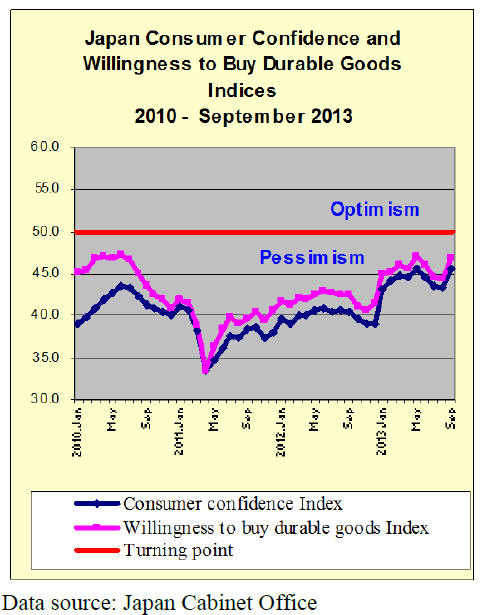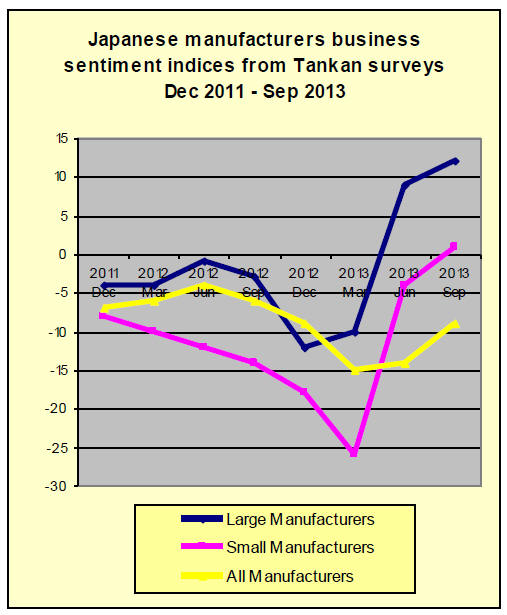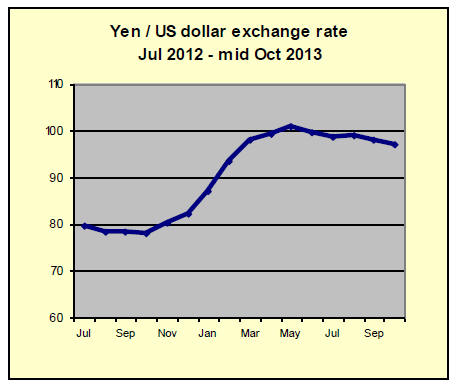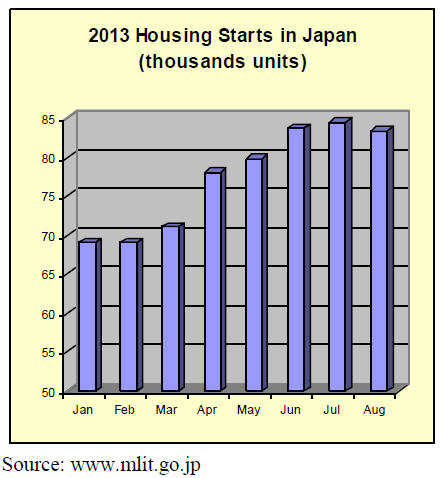Japan Wood Products
Prices
Dollar Exchange Rates of
12th October 2013
Japan Yen 97.50
Reports From Japan
Consumer confidence jumps to new heights
Consumer confidence rose more than expected in
September climbing to 45.7, edging closer to the 50 point
level which signals the change of sentiment from
pessimism to optimism.
The index for willingness to buy durable consumer goods
also rose sharply to 46.9, but this is still below the
threshold signalling optimism but still an encouraging
result for the government. For the latest Cabinet Office
data see: http://www.esri.cao.go.jp/en/stat/shouhi/shouhie.
html

Price movements suggest the end of deflation
In its September report Monthly Economic Report Japan‘s
Cabinet Office says the economy is on a moderate
recovery path:
Exports have been encouraging but recently the
upward trend has moderated
Industrial production is increasing at a moderate
pace
Corporate profits are improving, mainly among
large firms
Business investment shows signs of picking up,
mainly among non-manufacturing industries
Firms' judgment on current business conditions is
improving
The employment situation is improving
Private consumption is on a an upward trend
Recent price developments indicate that the
deflation is ending
The report says the shoots of recovery are expected to firm
as household income and business investment continue on
an upward trend. However, the risks of an extended
slowdown in overseas markets is still of concern.
In recent weeks exports have shown improvement
although the pace of expansion has eased. Exports to Asia
and the US have been flat recently; on the other hand,
exports to EU show signs of picking up.
In the short term the report says export prospects are
expected to continue upwards reflecting the steady
improvement in overseas economies. The improvement in
exports will be supported by the weaker yen.
The report does suggest that exports to Asia may weaken
as these countries struggle to adjust to the reduction in
capital flows caused by downsizing of the US stimulus
measures. For the monthly report see:
www5.cao.go.jp/keizai3/getsurei-e/2013sep.html
Business conditions continue to improve
In the third quarter of this year the sentiment of Japanese
manufacturers improved according to the recent survey by
the Bank of Japan and this paved the way for the
government to confirm that the consumption tax will be
increased from 5 to 8% in April next year.
Sentiment in the service-sector which is more closely
aligned to domestic spending also improved slightly.
Overall, with growing domestic consumption and the
indications that companies are increasing capital
investment the signs are that the policies of the current
government have cemented the foundations for growth and
an end to deflation.
The risk now is that Japanese companies will slow
expansion due to uncertainty in overseas markets,
especially the US. This stop and start attitude adds to the
challenge facing policymakers as they need to sustain a
positive sentiment to support wage growth and consequent
domestic consumption.

The BoJ Tankan shows that the index for big manufacturer
sentiment rose 8 points to plus 12 in September, the third
consecutive quarter of improvement. For the full Tankan
report see:
http://www.boj.or.jp/en/statistics/tk/index.htm/
Bumpy road ahead in promoting TTP in Japan
Japan‘s minister for economic revitalisation and the person
leading Japan‘s team at the TTP has said concluding the
talks with TTP partners was one of the ―fourth arrow‖ of
the government‘s determination to reverse stagnation of
the Japanese economy.
In the absence of any other concrete policies, joining the
TTP is probably the most encouraging move so far put
forward by the Japanese government. But there are huge
hurdles to cross before the TTP can be concluded as many
lawmakers are determined to protect sensitive agricultural
interests upon which the ruling party depends for electoral
support.
SME manufacturers could get new life from TTP
In an interesting article in the East Asia Forum, an
initiative of the East Asian Bureau of Economic Research,
Kensuke Yanagida and Boon-Loong Ngiang of the Asian
Development Bank Institute discuss the opportunities in
the TTP for Japan‘s small and medium sized enterprises
saying:
―Japanese small- and medium-sized enterprises (SMEs) in
particular would benefit substantially from deeper
integration across Asia as limitations in SME capabilities
and resources mean that nearer regional markets are
important for facilitating a firm‘s first steps abroad.‖
The authors point out that SMEs in Japan could benefit
from greater internationalisation of Japanese
manufacturing capacity.
They say further that ―Traditionally, Japanese SMEs
largely operated as suppliers for large enterprises as part of
the keiretsu system of integrated supply chain groups.
With some exceptions, SMEs tend to be domestically
oriented and export indirectly via the value chains of large
multinational enterprises and general trading houses.
In the post-March 2011 disaster environment these
arrangements are increasingly sub-optimal. As the
country‘s population continues to shrink at an alarming
pace, Japanese SMEs urgently need to seek opportunities
in faster growing regional markets to diversify demand
and remain viable.‖ For the full article see
www.eastasiaforum.org/2013/09/11/whats-holding-backjapans-
smes-from-regional-opportunities/#more-37768
Fear of yen appreciation derailing optimism
Worries over the time it is taking to for the US Senate and
Congress to reach an agreement to end the stalemate and
get US government agencies open and working is
worrying Japanese lawmakers as they fear a prolonged
delay will result in a stronger yen.
This risk has been increased as there is no agreement as
yet on raising the debt limit to avoid a US default. On
October 12 the yen was at a five week high against the US
dollar.

Trade news from the Japan Lumber Reports
(JLR)
The Japan Lumber Reports (JLR), a subscription trade
journal published every two weeks in English, is
generously allowing the ITTO Tropical Timber Market
Report to extract and reproduce news on the Japanese
market.
The JLR requires that ITTO reproduces newsworthy text
exactly as it appears in their publication.
For the JLR report please see:
http://www.nmokuzai.
com/modules/general/index.php?id=7
New JAS specifications on plywood
The Ministry of Agriculture, Forestry and Fisheries has
been reviewing JAS specifications and will newly
establish specifications on decorative structural plywood.
Several other revised plans have been approved at the JAS
examination committee.
In this latest revision, main purpose is to expand use of
plywood. Newly established specifications are for
decorative structural plywood. Surface quality of standard
plywood is revised.
Easing of bending strength of concrete forming plywood is
also revised on decorative plywood, several manufacturers
demanded establishment of new specifications.
This is structural plywood with decorative veneer with less
than 1 mm thick since this is used for ceiling. Product
specifications are the same as structural panel and gluing
standard is compliance with special type or type one and
bending strength is more than second class of structural
panel.
Regarding decorative veneer, dimensional stability and
crack free are required.
On side processing, tongue and groove processing on
decorative plywood was not allowed before but it takes
time for fitting at working sites. To respond to such
requests, now side processing is allowed.
Reviewing of surface quality of standard plywood is to
allow using lower grade veneer since surface materials
have been diversified from high grade tropical hardwood
to softwood and lower grade of hardwood. Specified grade
has been grade one and two, which are high grade. Now
quality is eased to allow using lower grade of class three
and four so that veneer used as core can be used for
surface.
August housing starts
Total starts in August were 84,343 units, 8.8% more than
the same month a year ago and this is twelve straight
months increase over a year earlier. Considering localized
torrential downpours in Western part of Japan, this is
much higher starts than expected.

Seasonally adjusted annual starts are 960,000 units. They
have been over 900,000 units for seven straight months
since last February. Enthusiasm for house purchase
continues with high probably because of coming
consumption tax increase.
August starts were up in all types of housing, owners‘ unit,
rental units, units built for sale both on detached units and
condominiums. Owners‘ units were 31,379, 11.2% more
than August last year and they have been increasing for
twelve consecutive months. There is steady demand in all
the areas.
Rental units were 29,548, 7% more than August last year
and this is six consecutive months increase. Condominium
starts were temporarily smaller than other types because of
completion of large units. Detached units built for sale
were 11,983, 11.3% more, twelve straight months
increase.
Wood based units were 47,901, 11.4% more out of which
traditional post and beam type units were 36,260, 13.2%
more.
Starts in three quake damaged prefectures continue high.
Iwate was 54.4% more than August last year. Fukushima
was 56.8% more while Miyagi was 5.7% less because of
high starts in August last year.
Increasing export of domestic logs
Export of domestic logs doubled in seven months. Export
has been increasing since last February and the first seven
months total was118,628 cbms, 94.7% up from the same
period of last year.
Main destination is China. The volume for China for the
first seven months was 45,726 cbms, 377.2% more. The
export of domestic logs in 2010 was 65,482 cbms then in
2011 was 100,134 cbms. In 2012, it was 113,598 cbms.
The largest factor is that China‘s import from North
America is declining and logs from Japan is
complementing shortfall. The prices of domestic logs
become competitive to logs from other sources because of
weakening yen. China becomes the top buyer over
Taiwan, which was top buyer before.
South Sea (tropical) logs
There is demand for good quality large diameter logs with
decent prices by plywood mills and sawmills in Japan but
there is very little such logs available.
Usually rainy season in the South East Asian countries
will start in November or December so this is time to buy
and accumulate logs for winter but in Sarawak, Malaysia,
rain falls have already started so that log supply is down
by 20% compared to the same month a year ago.
Since purchase by India is not so active, the log prices
have not gone up much but with tight supply, large price
reduction is difficult. Economic slump and weak Rupee
seem to impact India‘s log purchase.
Currently, Sarawak meranti regular prices are about
US$280 per cbm FOB, USUS$10 down from September
and there is no more offers of US$300. Meranti small is
about US$240 and super small is about US$220. They are
both weak.
Sabah kapur regular prices are holding at about US$370
per cbm FOB and serayah regular prices are about US$260
per cbm FOB.
Demand by Malaysian local sawmills and plywood mills
is stagnant as their order files are dropping so some log
suppliers give priority for export.
PNG is suffering prolonging foul weather so that log
supply is low.
Ocean freight of log ships is unchanged despite shipping
companies‘ request for higher freight.
Log prices in Japan stay high due to high FOB prices with
weak yen nearly 100 yen per dollar. Sarawak meranti
regular prices are about 10,200 yen per koku CIF, 200 yen
up from September.
Plywood mills try hard to push the sales prices up because
of higher log cost and higher electricity and glue cost but
progress is slow.
|